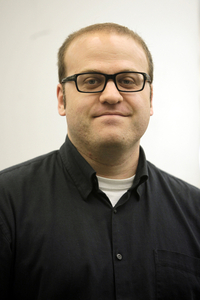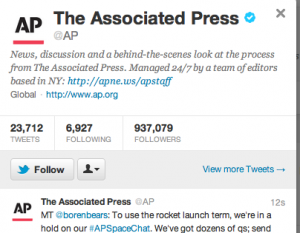This post is part of the Social Media Editor Series, featuring interviews with social media editors from news organizations about what they do and where they see social media in journalism going.
 Eric Carvin, who became the Associated Press social media editor in January, has an ambitious yet simple goal: for all of AP’s 2,500 journalists to use social media and use it well. That means using it not just to promote stories, but to make stories better.
Eric Carvin, who became the Associated Press social media editor in January, has an ambitious yet simple goal: for all of AP’s 2,500 journalists to use social media and use it well. That means using it not just to promote stories, but to make stories better.
He said one exciting way of doing this was to make use of locator services like Foursquare and location-based mobile video streaming for gathering news and user-generated content.
“More and more, sites and services specialize in helping you zero in on social and visual content based on where something is happening in the world,” said the Yale English grad and social media whiz.
Recently AP reached an agreement with mobile video broadcasting site Bambuser that allows AP to use video content from people around the world.
Carvin, 39, is first and foremost a journalist, having worked in various editorial positions at the AP over the past 12 years. Now, as social media editor, he monitors approximately two-dozen branded AP Twitter and Facebook accounts as well as the tweets of AP’s 1,000 known Twitter users (AP doesn’t require that its journalists disclose their Twitter handles).
“A lot of people ask about traditional journalism versus news over social media,” Carvin told The Content Strategist recently during a telephone interview, having just moderated a Society of American Business Editors and Writers panel about finding sources and stories through social media. “I don’t really see it as versus; I see it as connected.”
While social media provides up-to-the-minute information from around the world, journalists verify that information and place it in a larger context. “It’s important for professional journalists to bring their experience and judgement to bear on that content,” Carvin said.
In addition to finding news, sources and stories, Carvin said that social media can create a more intimate relationship between journalists and readers.
Although AP’s social media guidelines preclude its journalists from expressing “personal opinions on controversial issues of the day,” Carvin said the media company does not want to stifle its journalists’ online personalities. Instead he encourages AP journalists to blend their personal lives with their professional ones online.
 Doing so, Carvin said, simultaneously broadens journalists’ readership and makes them seem like “something other than a machine, which is how you can come across tweeting strictly about your day job.”
Doing so, Carvin said, simultaneously broadens journalists’ readership and makes them seem like “something other than a machine, which is how you can come across tweeting strictly about your day job.”
In that vein, those tweeting on AP’s main Twitter account write their initials after each post. Carvin himself divides his Twitter posts between his job and his love of urban foraging.
In an attempt to increase the effectiveness of its online presence, AP will soon be offering online training programs in social media for its staffers, involving news gathering and engagement strategies. Carvin said that while many AP journalists have Twitter accounts, they represent a wide range of social media savvy and not all of them are aware of the best practices.
“The news organization that knows how to best use these tools could really thrive in this world,” he said.